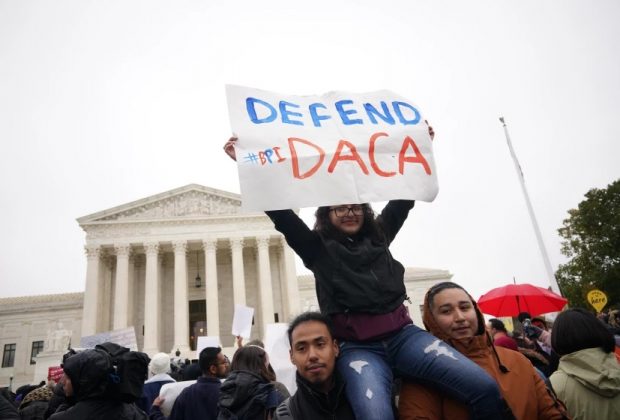DACA has helped undocumented young people build careers and families in the United States.
With the policy under immediate threat, it is long past time to provide certainty to recipients and their families with a pathway to citizenship.
By Phillip Connor | FWD.us | JUN. 14, 2022 | Photo by Mandel Ngan
Ten years after the Obama Administration created the Deferred Action for Childhood Arrivals (DACA) policy, DACA recipients have grown in many ways: youth who started as mostly high school and college students are now building careers and establishing families.
When President Obama announced the DACA policy in 2012, he described prospective DACA recipients as “young people who study in our schools, play in our neighborhoods, are friends with our kids, and pledge allegiance to our flag.” For years, elected officials and media outlets highlighted DACA recipients’ youth and the fact that they’d been educated alongside their U.S. citizen peers. Ten years on, DACA recipients are no longer children; the protections afforded by the policy have helped them to build their lives in the U.S., graduate from school, grow their careers, and establish their own families. But even while DACA recipients have grown and changed, the DACA policy has not kept up, and has been less effective over time because of court challenges resulting in closures of the policy for new applicants. Today, hundreds of thousands of these young people still live day to day facing the overwhelming uncertainty around their future in a country they have called home for decades.
When the DACA policy launched in 2012, DACA recipients were generally younger people who were in high school, or who were just beginning their college education or their careers. According to FWD.us estimates, the average age of DACA recipients in 2012 was 21 years.1 At that time, nearly half (45%) of approved applicants were enrolled in high school or college, while a slight majority (60%) participated in the labor force. For this first group, only slightly more than a third (38%) had graduated from high school, and roughly a third (35%) had attained some college education. As many were in school or just beginning careers, DACA recipients earned a median income of only $4,100 per year.
Ten years later, DACA’s beneficiaries have built families and careers in the U.S.
Initial DACA recipients in 2012 with active DACA status in 2022, by year
| 2012 | 2022 | |
|---|---|---|
| in school | 45% | 15% |
| in labor force | 60% | 85% |
| median income | $4,000 | $26,000 |
| finished high school | 77% | 99% |
| some college education | 35% | 47% |
| married | 17% | 37% |
| has children | 22% | 42% |
Note: DACA recipients based on eligibility for DACA in 2012.
Source: Augmented 2012 and 2019 American Community Survey data.
Fast forward ten years, and the overwhelming majority (at least 85%) of this initial group of DACA recipients from 2012 now participate in the labor force, while a small share is enrolled in a college or university program (less than 15%). Nearly all DACA recipients—99%—have graduated from high school, and about half (at least 47%) have attained at least some college education. This initial cohort of DACA recipients has increased their median income fivefold since 2012. Many are now building families as well: more than one-third (37%) of DACA recipients in this cohort have married, and more than 4 in 10 (42%) now have at least one child in the home.2

REYNA'S STORY
Over the last ten years, Reyna Montoya, part of the initial group of DACA recipients, has graduated college and now supports her community as a teacher. Reyna shares how DACA has created opportunities for her, and explains why Congress can and must do more.
Without question, DACA has been life-changing for the more than 835,000 young people who have qualified for its work authorizations and protections from deportation at some point in the last ten years—but much more work remains to be done. DACA was only ever meant to serve as a temporary policy offering immigration relief for young people, but it’s now become a permanent reality for DACA recipients, their families, and their employers as Congress has failed to pass permanent legislative protections.
Today, more than 600,000 DACA recipients are building careers and growing their families across the U.S.
Today’s DACA recipient population looks very different than it did ten years ago. That’s due in part because DACA hasn’t changed over the last decade, even to update the cutoff eligibility date by which applicants had to have entered the U.S. The result: the DACA-eligible population is largely the same as it was when the policy was announced in 2012. But of course, these individuals are now ten years older—and even more deeply ingrained into the fabric of American communities. Looking at the current DACA population—of which that initial cohort remains the majority—it’s clearer than ever that DACA recipients urgently need and deserve the certainty that a pathway to citizenship would provide.
More than 610,000 individuals make up the current DACA population, according to United States Citizenship and Immigration Services (USCIS). Although most DACA recipients (81%) were born in Mexico, they live in communities all over the U.S. The largest share of DACA recipients (29%) lives in California, followed by Texas (17%); the rest live in every state of the country.
DACA recipients are building lives and families across the U.S.
Number and characteristics of DACA recipients in the U.S.U.S.CaliforniaIllinoisFloridaNorth CarolinaNew JerseyColoradoTexasNew YorkArizonaGeorgiaWashingtonNevadaLos AngelesChicagoDallasHoustonPhoenixNew York CitySan FranciscoAtlanta
Select state or metro area for local estimates of DACA recipients
POPULATION:
611,000
AVERAGE AGE:
28 years
AVERAGE YEARS IN U.S.:
22 years
% IN LABOR FORCE:
77%
% WITH HIGH SCHOOL DIPLOMA:
91%
% WITH SOME COLLEGE EDUCATION:
44%
% MARRIED:
26%
% WITH CHILDREN:
32%
U.S. CITIZENS LIVING WITH DACA RECIPIENTS:
962,000
Note: Metro areas are based on 2013 Census Metropolitan Statistical Areas (MSA) borders. Age and years in U.S. adjusted to reflect 2022. All other characteristics are likely minimums since base data were collected three years earlier in 2019. DACA characteristics in states with less than 10,000 recipients are unavailable. DACA population estimates rounded to 1,000, with rounding at 100 for populations less than 1,000.
Source: Population figures for U.S. and states based on number of active DACA recipients at the end of 2021, as recorded by United States Citizenship and Immigration Services. All other estimates are based on FWD.us analysis of augmented 2019 American Community Survey data.
“After having lived nearly all of their lives in the U.S.,today’s DACA recipients differ little from U.S. citizens of similar ages.”
Most DACA recipients have only ever known the United States as home. Among current DACA holders, the average age is 28, and the average DACA recipient has lived in the U.S. for 22 years.3 The overwhelming majority have graduated high school, and nearly half have attained some college education. Most DACA recipients are working: more than three-quarters of DACA recipients participate in the labor force, contributing an estimated $11.7 billion to the U.S. economy each year. Meanwhile, more than one-quarter are married, and nearly one-third have at least one child at home.
Having largely grown up in the U.S., nearly half (45%) of DACA-recipients live in mixed-status families, meaning at least one member of their household is not a DACA recipient or an undocumented individual. For example, nearly one million U.S. citizens (960,000) live in households with a DACA recipient, according to FWD.us estimates. More exactly, we estimate that nearly one-fifth (18%) of DACA recipients—110,000 people—are married to a U.S. citizen spouse. Similarly, an estimated 590,000 U.S. citizen children live with parents who are DACA recipients.
FWD.us analysis also shows that after having lived nearly all of their lives in the U.S., today’s DACA recipients differ little from U.S. citizens of similar ages with respect to demographic and economic contributions. For example, the majority of both DACA recipients (85%) and U.S. citizens (82%) ages 24 to 31 participate in the U.S. labor force.4 More than half of both groups, DACA recipients (51%) and U.S. citizens (66%), have attained some college education. Additionally, both groups earn similar median annual incomes: current DACA recipients earn on average $23,000 a year, while that amount is $20,000 among U.S. citizens of similar ages. DACA recipients within these same age ranges are more likely to be married (26%) or have children (27%) than their U.S.-citizen counterparts (16% of whom are married, and 17% of whom have children).
“The only permanent solution for DACA recipients, their families, their colleagues, and other undocumented individuals is forCongress to pass legislation providing a pathway to citizenship.”
Congress must urgently do more for DACA recipients
DACA has provided life-changing benefits for young undocumented people who came to the U.S. as children. Without this policy, many hundreds of thousands wouldn’t have accessed higher education, started careers, or enjoyed the relative stability to start their families. At the same time, DACA protections remain precarious, and DACA recipients continue to live with tremendous uncertainty. The Trump Administration attempted to strip DACA recipients of their protections, an attack on the policy that continues in the courts today.
In fact, FWD.us estimates that as many as 600,000 people currently without DACA are eligible to receive the policy’s benefits but cannot have their application processed since U.S. District Court Judge Andrew Hanen vacated the 2012 DACA policy memo in July 2021. Although current recipients are permitted to continue renewing their DACA status, the terrible reality is that DACA could be voided in further court action as the Fifth Circuit Court of Appeals hears the case on July 6, and will likely rule on the DACA policy later this year. It is now more urgent than ever to provide a pathway to citizenship for DACA recipients. Unless Congress acts, DACA recipients who have relied on its limited protections for a decade could have no way to secure their status in the United States.
Critically, hundreds of thousands more undocumented young peoplecannot access DACA because they entered the U.S. after the policy’s cutoff date, and thus aren’t eligible for its deportation protections and work authorization. For example, even if USCIS were processing new DACA applications, the majority of undocumented high school graduates this year would be ineligible because they entered the U.S. after 2007. In total, FWD.us estimates that more than 2 million Dreamers—undocumented young people who entered the U.S. as children—aren’t currently protected by DACA. Their undocumented status hinders their ability to live free from fear and uncertainty, and blocks them from contributing more fully to their communities and our economy. Congress must act to provide these young Dreamers with immigration relief.
Also, many DACA recipients live in families where other family members are also undocumented. This means that even if Congress were to pass a pathway to citizenship for DACA recipients, the risk for family separation would still be great. Congress has the opportunity to keep millions of families together by not only seeing through on their promise to DACA recipients, but also providing a pathway to citizenship for their families and the rest of the undocumented population.
In his speech announcing the policy, then-President Obama declared that, “Precisely because [DACA] is temporary, Congress needs to act.” Ten years later, Congress has failed to meet that call. While a solution is long overdue, it’s not too late. Congress can act with urgency to provide permanent legislative protections to hundreds of thousands of DACA recipients.
The only permanent solution for DACA recipients, their families, their colleagues, and other undocumented individuals is for Congress to pass legislation providing a pathway to citizenship.With the termination of the policy possible through the courts, there is no more time to waste. DACA recipients have been forced to live their lives in two-year increments. The time is now to provide certainty to DACA recipients, their families, and the communities who rely on them. Congress must act without further delay.







